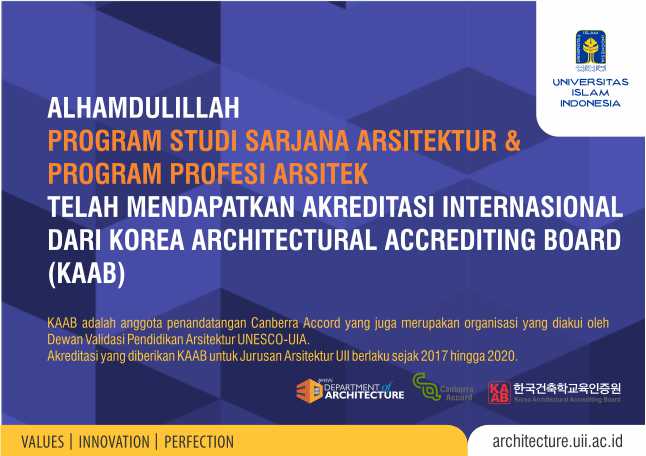[Communication]
01. Oral and Literal Communication
Ability to communicate architectural ideas in writing and speech, and the ability to communicate in a foreign language.
02. Drawing and Presentation
Ability to produce and present various types of architectural documents and reports.
03. Leadership
Awareness of leadership skills and methods in a collaborative work setting in architecture with people from various disciplines and interests.
04. Use of Diverse Media
Ability to demonstrate architectural ideas through appropriate media including sketches, written documents, and iconic models. Digital methods and the ability to apply method to design.
[Cultural Context]
05. Architecture, Science and Fine Art
Understanding of relationships among architecture, science and art.
06. Architectural History of the World and Tradition
Understanding of the diversity of cultural traditions and world architectural history.
07. Architectural History of Korea and Tradition
Understanding of national and regional ideological heritage and cultural traditions.
08. Architecture and Society
Understanding of the relationship between and mutual influence of architecture with respect to historical, social, regional and political factors.
09. Application of Precedents
Ability to review precedents in the field of urban design, architecture and landscape architecture with a critical view, cite them in the discussion of architecture and apply them in design of building and urban planning.
10. Human Behavior
Understanding of theories and methodologies clarifying the relationship between the physical environment and human behavior.
11. Sustainable Architecture and Society
Understanding of principles and theories of sustainability in architecture and urban areas.
[Design]
12. Form and Space Organization
Understanding and utilizing the basic principles of 2D and 3D forms and spatial structure that constitutes architectural and urban design.
13. Analysis and Program Writing
Ability to collect and analyze diverse information related to an architectural design problem, and ability to develop a consolidated architectural program.
14. Collaboration
Ability to recognize individual talent and cooperate with his/her team members as a member or a leader in a team or group work situation.
15. Cultural and Historical Context of a Site
Ability to formulate a design concept based on the understanding of the cultural and historical context of a site, systematically analyze and assess the acquired data and information acquired, and implement the findings into the design resolution.
16. Site Analysis and Land Preparation
Ability to understand the characteristics of a site in terms of natural, environmental, climatic and artificial conditions, and design requirements. Apply these characteristics in the planning of exterior space and land preparation.
17. Barrier Free Design
Ability to design a building to meet the various requirements of building users including the physically handicapped and elderly.
18. Safety and Protection
Ability to select appropriate systems of fire protection, emergency egress, and disaster protection based on the principles of life safety and disaster protection theory and facilitate them in the design process.
19. Integration of Building Systems in Design
Understanding of a building system and its constituent elements such as building structure, building envelope, composition of building, mechanical and electrical service and other building components, and the ability to integrate them into his/her design.
20. Design of Addition/Alternation, Repair, and Maintenance
Ability to assess and make changes or maintain the form or functions of existing buildings to renovate, rebuild, remodel and/or repair.
21. Housing Design, Urban Design and Urban Planning
Understanding of the basic principles of housing design, urban design, and urban planning. Ability to critically assess designs and plans, and to utilize the outcome in his/her own design.
22. Technical Document Writing
Ability to systematically demonstrate the design process from the early stage to the final phase and make a technically precise presentation to demonstrate the design intention and the result for each design phase. and produce design documents.
23. Consolidated Design
Ability to assess the various elements and components that constitute a building and integrate them to into his/her own design.
[Technology]
24. Principles of Structure
Understanding of the basic theories and principles of forces and building structure.
25. Structural System
Understanding of various building structure systems and their application in design.
26. Sustainability of Building Environment
Understanding of the sustainable method/systems for environmental control and the processes of circulation systems.
27. Indoor Environment Control Systems
Understanding of the basic principles and assessment methods of environmental control systems including thermal, lighting, acoustical systems, and energy management.
28. Building Service Systems
Understanding of the basic principles and appropriate applications of building service systems including mechanical, electrical, communication, and disaster protection systems.
29. Application of Computer Technology and BIM
Understanding of the utilization and application of computers in the design process and the integration of a computer-aided design system such as Building Information Modeling technique.
30. Building Materials and Components
Understanding of principles, conventions, standards, applications and restrictions regarding the production and use of building materials, components and assemblies.
31. Recycling and Hazard Protection
Understanding the process of recycling construction materials and building wastes, and their potential hazard to the environment.
32. Construction Process and Management
Understanding of the construction process and the management skill to effectively facilitate physical, human, and technical resources within the local context.
[Professional Practice]
33. Ethics of Architects and Professional Obligation
Understanding of the ethics, responsibility and professional obligations to society.
34. Role of Architects
Understanding of the architect’s role in the construction process, including: procurement, contract, planning, design, bidding, construction, observation, and post- occupancy evaluation (POE).
35. Construction Documentation/Manual
Awareness of the different types of documents required to carry out a competitive, responsible and professional service.
36. Building Code and Regulation
Understanding of construction laws and regulations related to public safety and welfare, property rights, building codes and regulations, design, construction and practice, and the legal responsibility of architects.
37. Operation and Management of Architectural Practice
Understanding of the basic facts and management skills required in the operation of an architecture practice office.


